10 Most Famous Fountains in Rome
Rome, Italy is a metropolis that'south teeming with some of the almost illustrious artwork and architecture in the earth. It is abode to numerous museums that are each filled with artwork that frequently dates dorsum to the Italian Renaissance, which is widely considered to take been the pinnacle of creative expression in all of human history.
Aside from the ii-dimensional artwork, in that location are countless masterpieces that are three-dimensional works in the city as well.
The metropolis's fountains are deeply-rooted in the history of Rome itself, as well as the more aboriginal foundations of the Roman Empire, which spanned the get-go v centuries A.D.
Water was as much a function of Roman history as whatsoever other and some of the most famous Roman aqueducts and fountains are nevertheless standing to this mean solar day across much of Italia and other parts of the earth.
The Roman Empire was the starting time that successfully manipulated the flow of water and made it possible to construct baths, drinking fountains and other works thanks to the culture's incredible engineering.
Fountains were a fundamental part of Roman culture and the significance of fountains take been more or less characteristic of Italian civilisation as a whole over the concluding several centuries.
In this commodity, we volition identify 10 of the most famous fountains in Rome and provide some of the history related to each construction.
Famous Fountains in Rome
one. Trevi Fountain (Fontana di Trevi)
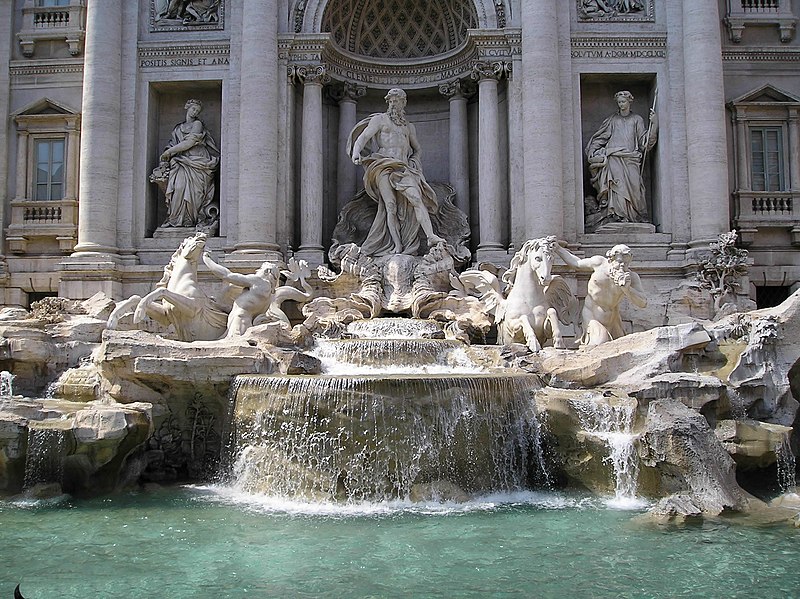
One of the most well-known fountains in the city of Rome is the Trevi Fountain (Fontana di Trevi). This structure is situated in front of the Palazzo Poli, which is a palace that's located just over 2 kilometers e of Vatican Metropolis and is fed by the Aqua Virgo, or Acqua Vergine.
The Acqua Vergine is one of the aboriginal Roman aqueducts that was originally constructed in the 1st century B.C. This aqueduct feeds pure spring water into the city of Rome and is still in utilize today.
Pope Clement XII orchestrated a contest in 1730 in which various artists submitted designs for the fountain and the winner would be selected to have a commission from the pope to come across that the fountain was redesigned.
Alessandro Galilei was initially named the winner, but the people of Rome protested every bit Galilei was a native of Florence and there was serious demand that Nicola Salvini, originally from Rome, be awarded the commission.
The overall blueprint of the fountain includes the figure of Triton, the Greek god of the body of water, property the reins of a chariot which is made of a giant sea beat that was given to him by Oceanus, a god that pertains to h2o and the Earth'due south rivers.
The chariot is driven by hippocampus, which are Roman body of water-horses believed to accept been used past these gods.
2. Fountain of the Four Rivers (Fontana dei Quattro Fiumi)
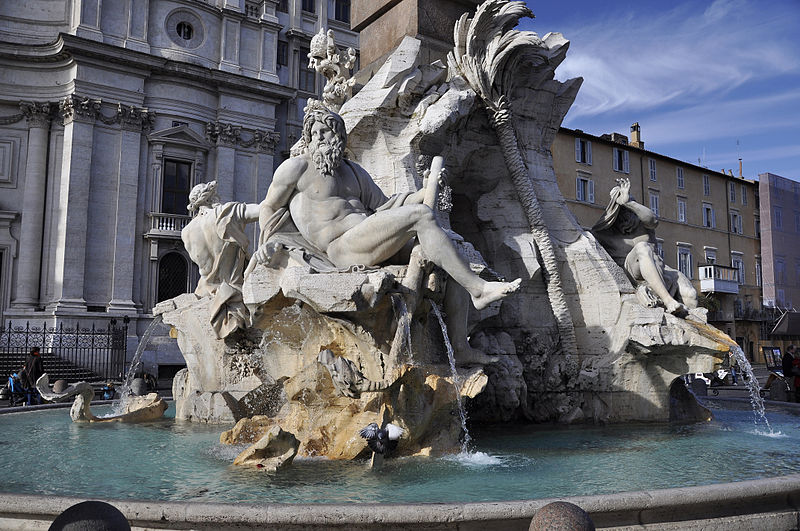
The Fountain of the Four Rivers (Fontana dei Quattro Fiumi) is arguably one of the virtually famous structures in all of Rome every bit it incorporates many different elements of the city'south history. It's built in the middle of the Piazza Navona, which is a major tourist site that's surrounded by historic structures and architecture.
The fountain itself was deputed in 1651 by Pope Innocent 10 who wanted the structure to be built in the piazza as it was home to his family's palace, as well as the church of Sant'Agnese in Agone.
The fountain'southward statues include the four major river gods from Roman mythology, also every bit a massive Egyptian obelisk, which is decorated with hieroglyphics, as well as the Pamphili family crest, which is the epitome of a dove belongings an olive co-operative in its beak.
These four river gods too represent the four major rivers that be on the Globe's iv virtually populated continents. These include the Danube in Europe, the Nile in Africa, the Rio de la Plata in the Americas and the Ganges in Asia.
The pattern of the statue was created past Gian Lorenzo Bernini, who is 1 of the most famous sculptors and architects from Italian culture and was the virtually prominent artist to take worked in sculpture from the Baroque era.
iii. The Fountain of Neptune (Fontana del Nettuno)
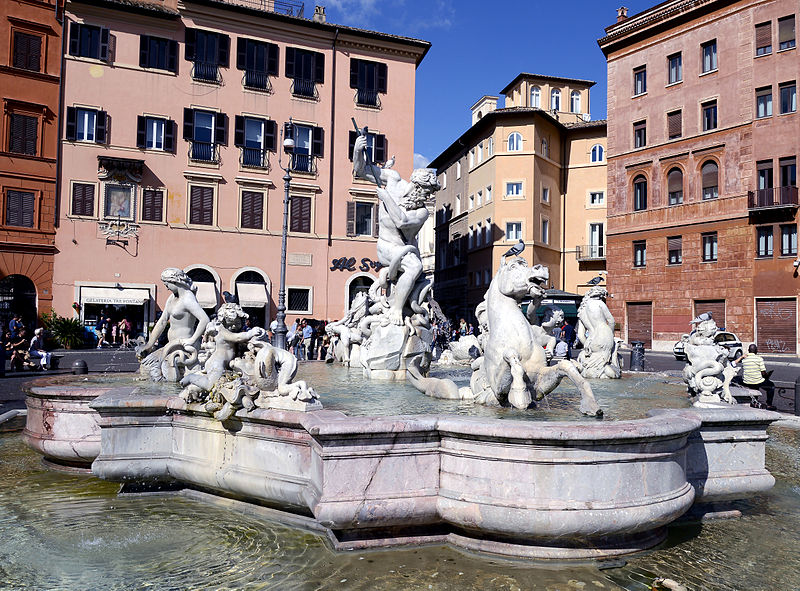
Located in the northern finish of the sprawling Piazza Navona, the The Fountain of Neptune (Fontana del Nettuno) is another one of Rome'southward most historic fountains.
This structure is much smaller than some of the other fountains that were designed during the same time period at the end of the Italian Renaissance era.
The fountain'south design and construction was commissioned by Pope Gregory Xiii in 1574. The work itself was designed by Giacomo Della Porta who created a relatively uncomplicated fountain that consisted of a large basin.
The lower portion of this basin consisted of white marble while the upper portion was fabricated of stone that was taken from Pietrasanta, which is a small town that'southward located on the northern declension of Tuscany.
The fountain was renovated in the 1870's based on sculptures that were designed by Antonio della Bitta. The main sculpture in the fountain depicts Neptune, the Roman god of h2o, wrestling with a giant octopus.
4. Fountain of the Naiads (Fontana delle Naiadi)
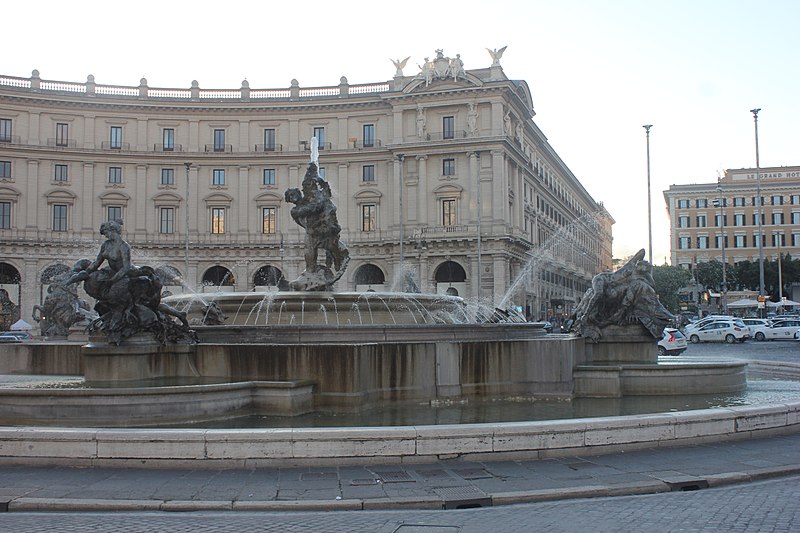
The Fountain of the Naiads (Fontana delle Naiadi) is 1 of the more than picturesque structures in the city of Rome. Information technology'southward situated inside the Piazza della Repubblica, which is located on Viminal Loma, ane of Rome's seven hills.
The fountain'south bones structure was designed past Alessandro Guerrieri in 1888, but some other artist would add on to the structure in 1901.
Guerrieri'southward pattern included the placement of 4 lion statues that were made of plaster. This original design included a sculpture of the Greek sea-god, Glaucus, in the center. The fountain was later renovated past Mario Rutelli, who added the fountain'south 4 bronze sculptures to replace the four lions.
These four new bronze statues were Greek naiads, or nymphs, who are as spaced apart from ane some other around the fountain.
5. Triton Fountain (Fontana del Tritone)
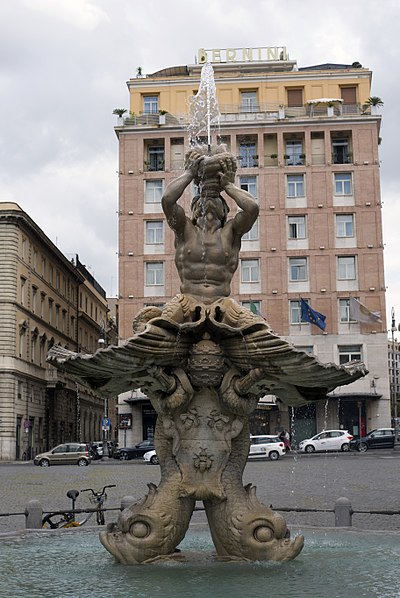
Another prominent fountain that was designed by master sculptor and architect, Gian Lorenzo Bernini, is the Triton Fountain (Fontana del Tritone).
This construction is located at the entrance of the Palazzo Barberini, which is home to the Galleria Nazionale d'Arte Antica, Italian republic's national art gallery.
The unique fountain is carved of limestone and features the figure of Triton perched atop a sea beat out that's being supported by 4 mermaid tails. The muscular effigy of Triton is posed so that he's holding a conch shell to his lips where a small-scale stream of water spouts out of.
The fountain'south original design included a stream that shot out of the conch shell and spouted much higher into the air than the current stream of h2o.
6. Fountain of the Gunkhole (Fontana della Barcaccia)
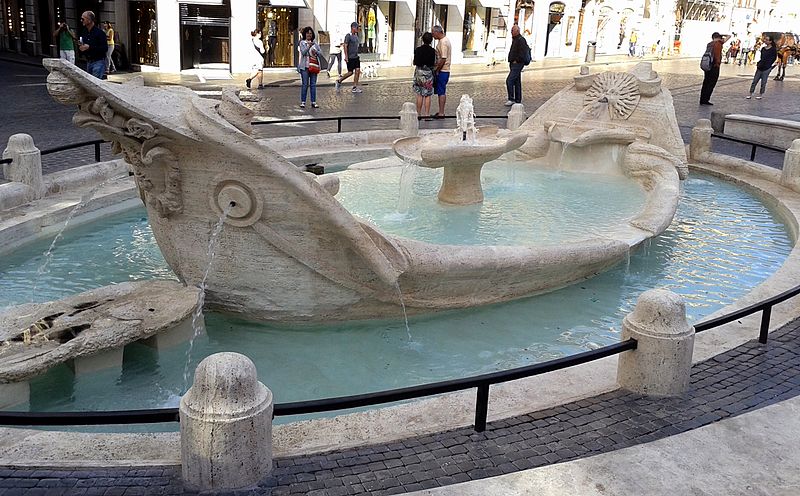
Rome'due south Fountain of the Boat (Fontana della Barcaccia) offers i of the most singled-out designs of any fountain in the unabridged urban center. Information technology'due south situated about the Castilian Steps, located in the city'south Piazza di Spagna.
The fountain is made with a Bizarre-fashion design and was initially commissioned past Pope Urban VIII in 1623. This effort to commission the fountain was part of an overall aim by an earlier pope to construct ane fountain in each of Rome's major piazzas at the time.
This fountain was designed by Pietro Bernini, father of Gian Lorenzo Bernini—arguably the most famous Italian sculptor from the Baroque era.
Many scholars and historians believe the sculpture was completed by Pietro with the help of his young son, Gian Lorenzo since the elder Bernini died in 1629 presently after the fountain was finished.
The fountain'southward design was inspired past a legend that tells of a boat being carried by floodwaters from the River Tiber in 1598 which eventually landed in the middle of the piazza.
7. Fountain of the Frogs (Fontana delle Rane)
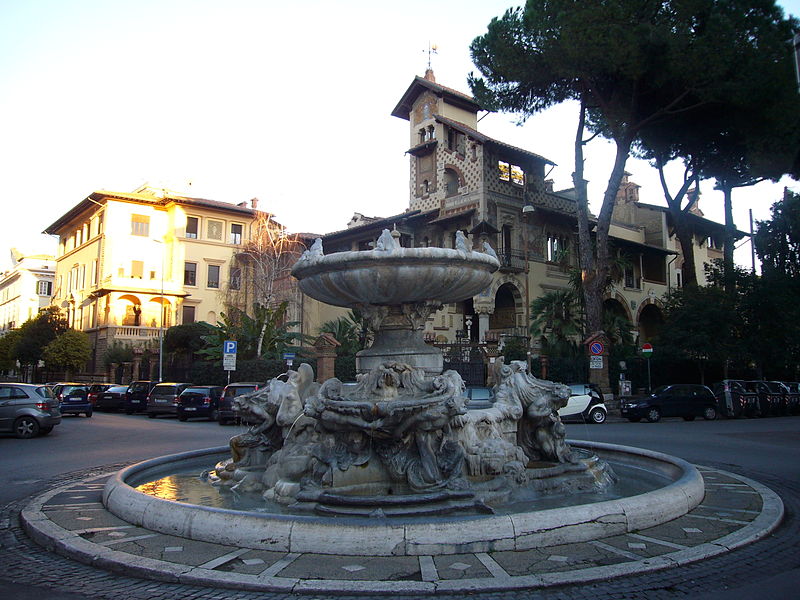
One of the more hands-recognizable works in the city of Rome is the aptly-named Fountain of the Frogs (Fontana delle Rane). This unique fountain features 12 frogs that are situated around the fountain in various poses.
The Fountain of the Frogs was designed by Gino Coppedè, who was a prominent builder during the early 1900'south who was known for his stylistic designs. In fact, the district where the fountain sits is named the Coppedè District afterward the famous artist.
Built in 1924, this fountain also features 4 male figures that are seen with angling nets being dipped into the pond department of the structure.
Many historians believe this fountain was created as a tribute to Bernini'due south work that's situated in the Piazza Mattei and features a number of turtles in the fountain's sculpture.
8. Fountain of the Pantheon (Fontana del Pantheon)
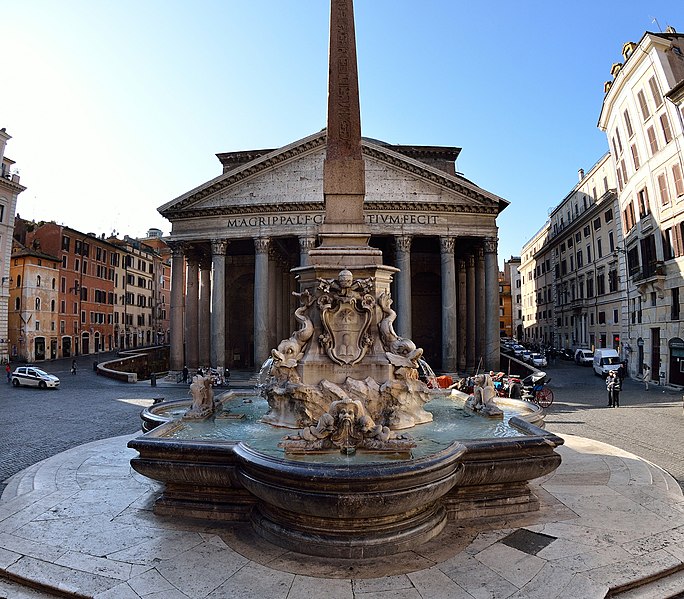
The Fountain of the Pantheon (Fontana del Pantheon) is another singled-out structure that likewise features a large obelisk in the center of the piece of work. Located in Rome'southward Piazza della Rotonda, this fountain was commissioned by Pope Gregory Thirteen and designed past Giacomo Della Porta in 1575.
The fountain's sculpture was done past Leonardo Sarmani, who was a prominent artist and sculptor during the time menstruation.
The obelisk is a re-create of the famous Macuteo obelisk, which was created past Ramses II during his reign in Egypt. Pope Cloudless Eleven had the fountain's design slightly modified in 1711, commissioning Filippo Barigioni to complete the work.
9. The Turtle Fountain (Fontana delle Tartarughe)
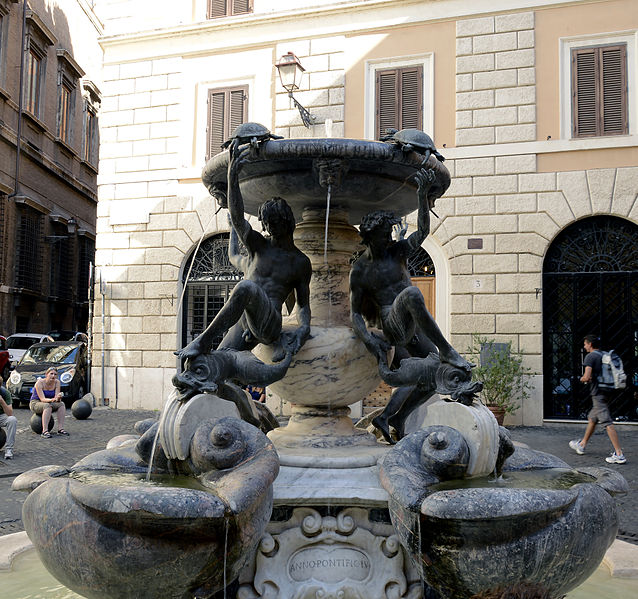
The Turtle Fountain (Fontana delle Tartarughe) is i of the most well-known fountain works associated with Gian Lorenzo Bernini and is amidst the most distinct in the metropolis of Rome.
This beautifully-designed fountain was originally created in the 1580's past two famous architects named Giacomo della Porta and Taddeo Landini.
Della Porta'south initial blueprint is one that is based on a copy of other Roman fountains that were believed to exist designed during the early Roman Empire.
Bernini'due south turtles were added afterward in 1658, but the fountain has besides experienced other renovations since it was synthetic.
10. Fontana dell'Acqua Paola
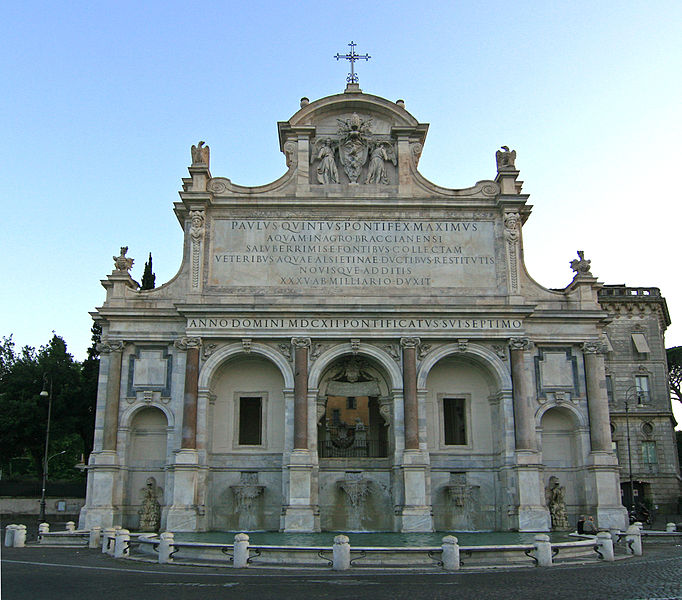
The Fontana dell'Acqua Paola is a large monumental work that's located on the Janiculum Hill, which is another of Rome's vii hills. The fountain was an attempt that was commissioned past Pope Paul V in 1612 to mark the cease of the Acqua Paola aqueduct, which had recently been restored to bring water once over again into the metropolis.
It was originally intended to be a source of drinking water for the residents of the area, but has since become a tourist allure that's rich in history. The structure was carved out of white marble and designed by Giovanni Fontana, who was function of a family of prominent architects during the fourth dimension period.
The fountain'due south design praises the efforts of Pope Paul Five and features various elements such as the Borghese family coat of artillery, as well every bit an hawkeye, dragon and angels.
Source: https://www.artst.org/famous-fountains-in-rome/
0 Response to "10 Most Famous Fountains in Rome"
Post a Comment